
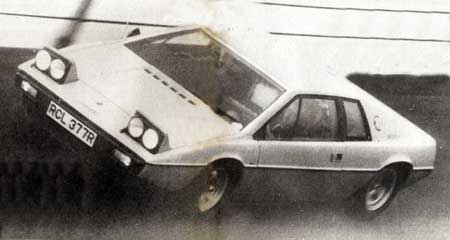
Lotus Esprit S1
Fast and striking mid-engined two-seater.
Despite £8000 price tag,
cheaper than rival supercars which it matches in several departments.
Roadholding, ride, brakes and gearchange outstanding.
Wretched rearward visibility and excessive noise when extended
mar an otherwise impressive driving machine.
Motor, 29 January 1977
With the introduction of the mid-engined Esprit at the end of 1975, Lotus completed the establishment of their new model range and with it their transformation into manufacturers of high-performance luxury cars in the Ferrari/Porsche class. The Elite and Eclat appeared as dual replacements for the Elan + 2, and now the Esprit, successor to the Europa, is gradually becoming available on the home market.
Despite being a two-seater, the Esprit is actually 1.75 inch wider than the Elite/Eclat, due perhaps to a certain extravagance in its conception, its glass fibre body being based on a styling exercise created by Giugiaro and exhibited at the 1972 Turin Show. For the same reason, possibly, the new bodyshell suffers from considerable visibility problems. The Esprit, however, is 1.75 inch shorter in the wheelbase, 10 inch shorter overall and 3 cwt lighter than its front-engined stablemates.
The Esprit uses a similar steel backbone chassis and the same water-cooled 16-valve dohc engine of 1973cc capacity to be found in all current Lotus road cars. With twin progressive-choke 45 DHLA Dellortos and a 9.5:1 compression ratio, it produces a health 160bhp.
Although the gearbox of the Esprit has five speeds, it bears no resemblance to the Maxi-based unit found in the other Lotus cars, but is supplied by Citroen, for whose now-defunct SM it was developed by Maserati. It also uses the SM linkage. Lotus have a supply contract with the French company for the next five years.
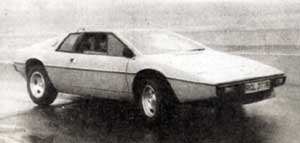
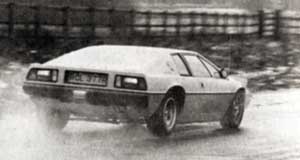
The Esprit has double-wishbone front suspension but unlike the other Lotuses, the hubs and links are taken from the Opel Ascona. The rear suspension, in which the driveshafts double at upper links, is traditional Lotus. Braking is by discs all round, mounted inboard at the rear.
Like all the new Lotus models the Esprit is very much more expensive than its predecessor. Originally estimated at £5000 at its introduction in 1975, inflation has increased the price to nearly £8000. Even at this level, however, the car is £2000-£5000 cheaper than other high-performance sporting cars such as the Porsche 911 N, the Ferrari 308 GTB, the Maserati Merak and the Lamborghini Urraco – supercars the Esprit matches in some respects, not in others.
It is too wide to swoop through traffic with the same cheekiness as the Europa and Elan, and it lacks the steering sensitivity of those two cars. On the other hand, its ultimate adhesion limits are so high that few owners are likely to find them, let alone get themselves into difficulties; if they do, they will find the handling very forgiving even on damp surfaces. It s mainly in the areas of noise suppression and visibility – plus a few other niggling faults – that the car disappoints.
Even so, we don't doubt that the Esprit will be a sales success for Lotus for it is something of a trendsetter in sportscar design. However, we hope that development will make it quieter at certain speeds, and easier to see out of.
Performance
The twin-cam, belt-driven Lotus engine is very efficient, for from its 1973cc no less than 160 bhp is extracted at 6200 rpm, and it produces 140 lb ft to torque at 4900 rpm. This represents more than 81 bhp/litre which is a great deal more than most of its rivals can claim.
The Esprit we tested was not hampered by such encumbrances as air conditioning and the steering is not assisted, so with a lower weight and less power 'leaks', one would expect an appreciable improvement in performance over the other Lotuses. Indeed there is, though we could not approach the claimed figures of 0-60 in 6.8 sec or the standing quarter in 15.0 sec, which would really put the Esprit into the supercar class.
However, the time of 7.5 sec and 20.7 sec to 100 mph we got is still excellent. Up to 100 mph it feels quick, but thereafter the acceleration begins to tail off. We just managed to pull 120 mph within the confines of MIRA's acceleration straight.
The Esprit is little slower on acceleration than many more expensive rivals partly because of its superb ability to get off the line so smartly. The traction is astounding – even when the clutch is engaged violently at high engine revs, the Esprit rockets forward leaving only short black lines on the road thanks to its limited slip differential which is a standard fitment.
Lotus claim a maximum speed of 138 mph, which we had no opportunity to verify. However, at 125 mph it had something in hand so over 130 mph is probably feasible.
Mid-range acceleration is very brisk, all the increments between 50 mph and 90 mph in fourth gear taking between 7.2 sec and 7.6 sec: this is the vital range for overtaking and the Esprit performs very well in it. Bearing in mind that top is intended purely for cruising, acceleration in this gear is not bad either.
Economy
All Lotus engines these days are identical in terms of power output and torque, so the only differences between the Esprit and the Eclat/Elite range are the lower gearing, weight and aerodynamics. Our touring figures of 25.2 mpg is poorer than we expected, for the Eclat managed 27.8 and the Elite 503 25.4 mpg.
Lotus have made a great play about the economy of their range. We achieved 20.3 mpg in the course of our test, quite good for a high performance two-litre car. Restrained driving could give over 25 mpg though we doubt if anyone would approach what Lotus describe as an 'overall touring' figure of 33 mpg. A reasonable range of 373 miles is obtainable from the 14.8 gallons contained in twin tanks.
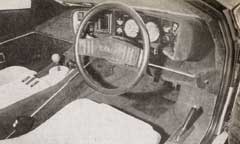
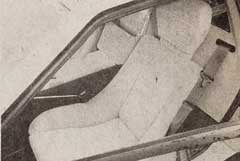
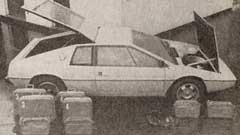
Transmission
Gear linkage design is frequently the worst feature of cars whose engines are situated behind the driver. However, excellence with this configuration is by no means unattainable, as Porsche so ably demonstrate. The gearchange of the Esprit is even better – lighter to move and less notchy – and an improvement over that of the last Europa.
The gate is narrow with a short throw and the pattern is conventional, with fifth set over to the right, and reverse below it. Accidental selection of the latter is prevented by the necessity to lift the lever over an obstruction.
Fifth gear is described on the lever as 'Overdrive', an apt description of its nature though technically incorrect. At relatively high speeds in top, up to about 90 mph, the Esprit is quite economical and reasonably quiet. The other ratios are equally well suited to the characteristics and purpose of the car, being nicely spaced with maxima of 40,61,89 and 121 mph. The engine will not pull from below 40 mph in top, but it is much more flexible in fourth. The clutch is light and smooth.
Handling
The traction is almost beyond compare in a road car, even better than that of a Porsche, especially in the wet. The fat tyres are 250s all round, but they are 70-series at the rear and 60-series at the front on 7J and 6J rims respectively, instead of the differing tyre widths used in early versions. The limit of adhesion on dry surfaces is astonishing and even on wet roads it is very impressive.
The Esprit is an exceptionally safe car, though perhaps not so much fun to drive as the Elan Sprint. It does not respond to an extrovert tail-out driving style – indeed such an attitude is very hard to achieve; an increase in power merely increases the understeer, while lifting off in mid-corner provokes a mild tightening of the line.
Unlike the front-engined cars, the Esprit is not offered with power-assisted steering. Its rack and pinion system is nicely weighted but does not have quite the same precision as that of its forebears. It is a bit lifeless until lock is applied, and even then there is not quite the sensitivity and feel we had expected. On the other hand the car is astonishingly stable and runs arrow straight at very high speeds, the bib spoiler holding the front end down well except in strong cross winds.
Brakes
Large discs – inboard at the back – are fitted all round. The excellent servo has not impaired the sensitivity of the braking, which is stable and reassuring. Relatively low pedal pressures achieve 1.0g stops, and despite the fact that the pads began to smell, no fade showed up in testing.
Accommodation
The Esprit is designed to carry two adults and their luggage, and it fulfils this function better than most mid-engined cars. For tall and bulky people, getting in and out is rather awkward despite the wide doors, and in bad weather the cloth-covered sill over which you must slide gets wet and dirty; it's also likely that your shoes will scuff the seat on the way in.
Once inside most people will be very comfortable indeed for although headroom is restricted, there is lots of legroom and the interior does not feel cramped for claustrophobic.
The huge rear door is hinged at the door pillar line and supported by a pair of struts. It gapes to allow easy loading over a low ledge, but the carpet of our test car was soaked with rain, causing severe internal condensation. The luggage area is generous for this type of vehicle, and a tonneau is supplied to shield valuables from the gaze of potential miscreants. A small amount of extra luggage may be stored in the nose section, which is mostly taken up by the spare wheel. Apart from the unlockable glove box and a small cubbyhole on the central armrest there is scarcely any stowage space in the passenger compartment, though flat objects may be squeezed behind the seats.
Ride Comfort
The Esprit's ride is generally impressive, for major road surface irregularities are ironed out smoothly; only the occasional deep rut causes jarring. Once again Lotus have proved (if proof were needed) that it is not essential to sacrifice a civilised ride in pursuit of taut handling, or indeed vice versa.
Roll is virtually absent, there is no appreciable float, and hardly any pitch or squat even under severe braking and acceleration.
The only reservation we have about this aspect of the Esprit concerns a high frequency tremor – almost pronounced enough to be called a vibration.
At the Wheel
Drivers of average size will almost certainly find the interior of the Esprit very much to their liking. The stylish lightweight seats with their practical built-in headrests are nearly as comfortable as they look, and there is sufficient fore/aft adjustment in the runners. However, the backrests – which don't give enough side support – are fixed so you are forced to adopt a semi-reclining position which not everyone liked.
Apart from restricted headroom, the larger driver may be put off by the interference of his knee with the comparatively large, non-adjustable steering wheel when operating the clutch; similarly, anyone with big feet will find the pendant pedals too close together. Nor is there much space between the clutch pedal and the central tunnel; a left-foot rest would be welcome. Moreover, there is a danger of depressing the throttle linkage crossbar while resting your left foot.
The relationship between the major controls is generally good, except for the handbrake, which is too far forward on the right.
Most of the minor controls are set into the neat instrument pod which must greatly simplify and reduce the cost of LHD conversion, and they are all within easy reach of most drivers though some will find the lefthand switches too far away. The lefthand stalk operates the two-speed wiper and the windscreen washer, and the indicators, flasher, main beam and horn are operated by the other. The coke lever and the electric window lifters are handily placed on the central console, behind the gear lever.
Visibility
Lotus have no doubt applied much thought to this knotty problem, but a great deal more will be required if they are to solve it, for it has many of the worst faults associated with a mid-engined car, plus a couple more caused by reflections in the division window and the rear side panes.
Forward visibility is awkward for parking unless the headlights are raised, though it is quite good otherwise, marred only slightly by thick pillars and light reflection. It is essential at all times to remember that not only is this a very wide car, but also that its widest point, over the rear wheels, is out of sight. Fortunately, a plastic scuff strip along the waistline protects the paintwork from minor scrapes.
The view out of the rear screen is acceptable once the car is on the move, but rearward and rear three-quarter vision is very poor indeed for reversing or manoeuvring in tight spaces. Emergence from angled side turnings demands a van driver's technique. An additional problem we encountered was misting-up of the rear side windows, which do not contain a heating element and cannot be reached from the passenger compartment. Even the heater for the back window failed to cope with condensation from the wet boot carpets.
The single two-speed wiper has a broad sweep and the flat glass aids its efficiency, but a small area to the right adds to the blind spot caused by the thick pillar on righthand bends. The electrically lifted twin headlights have a good range on both dipped and main beams, but they suffer from vibration over bumps which makes them flicker.
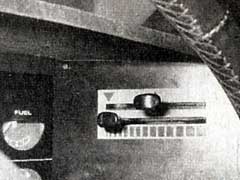
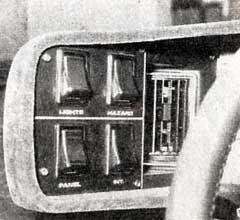
Instruments
The Esprit's Veglia instruments are attractively styled with green backgrounds and quite well calibrated. Two major dials – the speedometer and rev-counter – dominate the console, with an oil pressure gauge and water temperature gauge to the left and the fuel gauge and a battery condition indicator to the right, all these four instruments being semicircular. There is a display of warning lights running along the top of the console.
Heating
The heating controls, grouped on the right of the console, are clearly marked and easy to understand, though invisible in the dark. There are two levers which move in the horizontal plane, one for distribution and the other for temperature control which is progressive in its action. Even with the two-speed fan full on the output of hot air is not enormous, though once warmed up the heater copes well enough. Demisting takes a long time, and there is no provision for clearing the side windows.
Ventilation
Although directional control of the two face-level vents is admirable, there is little throughput. Exhaust gases wafted into the car in traffic takes a long time to waft out again, and usually it is advisable to open a window in such circumstances.
Noise
For nearly £8000 you'd expect peace and quiet and that any intruding noise would at least be a nice noise: the Esprit is disappointing in this respect. The engine cover does little to banish the loud boom that is particularly obtrusive beyond 4000 rpm. Even so, as fifth is so high, the engine remains fairly quiet when cruising at 90 mph. The transmission is relatively quiet.
Wind roar, poorly suppressed at speed, comes mainly around the door pillars. There's also quite a lot of bump-bump over really rough surfaces though on the whole road noise is quite subdued despite the size of the tyres.
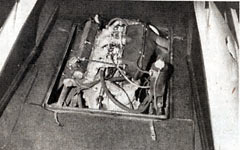
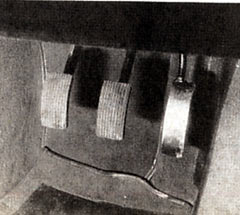
Equipment
The Esprit's specification includes electric windows, a laminated screen, heated rear window, door mirror, hazard warning lights, inertia-reel seat belts and a two-stage panel light. What it does not include is a clock, rear window wiper and a cigarette lighter, all extraordinary omissions.
The attractive Wolfrace wheels are not, as may be seen from the pictures, matched front to rear. The spare is a front wheel and tyre so in the event of a puncture at the back caution must be observed. A small toolkit is supplied as well as the jack and wheelbrace.
Finish
The interior of the Esprit is plush and modern. Our test car was trimmed in brown suede-like fabric, colour coded to the cream brushed nylon of the seats. The carpet's beige shade fell somewhere between these two. Surprisingly, the carpet in the boot is grey. There is an alternative of tartan and green cloth.
Despite one or two creaks and rattles in our test car, the Esprit is fitted out quite well, though we would like to see scuff-plates on the doors. We were not impressed by the flimsy sun visors or hinges of the glove box, while the positioning and size of the ashtrays renders them virtually useless.
The external finish is excellent, showing just how much Lotus have advanced in recent years.
In Service
After the first free service at 500 miles, Lotus recommend a minor service at 5000 miles and a more major overhaul at 10,000 miles. There are 70 Lotus dealers in the UK.
Self-servicing should not be too difficult. Minor attention may be given to the engine by raising the rear section of the engine cover, while for more major work, the entire cover may be removed. Most major components are within easy reach, though the oil filter and distributor are hard to get at. The battery is hidden under a removable shelf beside the offside rear side window. We noticed that parts of the rear chassis rails where exposed to the elements and one was already showing signs of rust.
Conclusions
Although much more expensive than the Europa which it replaces, the Esprit is between £2000-£5000 cheaper than other high-performance sporting cars and if this doesn't ensure that it sells, the car's striking looks surely will.
The performance from its modestly sized engine is excellent and up to certain speeds it is little slower than many of its rivals. It is also more economical, and though we expected better than 20.3 mpg the car achieved overall.
The car's roadholding, braking and five-speed gearbox are all outstanding. Traction especially is almost beyond compare in a road car, even better than that of a Porsche, particularly in the wet. Only severe visibility problems mar this otherwise safe and satisfying car.
The visibility problems, exacerbated by side window condensation as a result of a soaked boot carpet, and excessive noise when extended, are problems which Lotus must urgently tackle. Those faults eliminated, Lotus surely will sell every Esprit they can make.
The RIVALS
The Esprit is not short of rivals. Obvious ones not included are the Porsche 924 (not yet tested), Ferrari 308GTB (insufficient figures) not to mention Lotus's own Elite and Eclat and TVR's Turbo






|
|